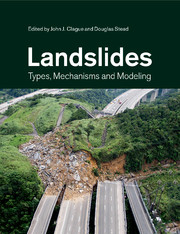Book contents
- Landslides
- Landslides
- Copyright page
- Contents
- Contributors
- Preface
- 1 Landslide hazard and risk
- 2 Landslides in the Earth system
- 3 Earthquake ground motion and patterns of seismically induced landsliding
- 4 Landslides at stratovolcanoes initiated by volcanic unrest
- 5 Mobility of long-runout rock avalanches
- 6 Rapid rock-slope failures
- 7 Risk assessments for debris flows
- 8 Landslides in quick clay
- 9 Controls on the distribution of major types of submarine landslides
- 10 Tsunami hazard assessment related to slope failures in coastal waters
- 11 Physical impacts of climate change on landslide occurrence and related adaptation
- 12 Landslides and geologic environments
- 13 Numerical modeling of rock-slope instability
- 14 Remote sensing techniques and landslides
- 15 Engineering geomorphology of landslides
- 16 Developments in landslide runout prediction
- 17 Models of the triggering of landslides during earthquakes
- 18 Slow rock-slope deformation
- 19 Landslide monitoring:
- 20 Groundwater in slopes
- 21 Soil slope stabilization
- 22 Rockfall characterization and modeling
- 23 The 2006 Eiger rockslide, European Alps
- 24 Randa:
- 25 Characterization and management of rockslide hazard at Turtle Mountain, Alberta, Canada
- 26 The Åknes rockslide, Norway
- 27 A seismometric approach for back-analyzing an unusual rockfall in the Apennines of Italy
- 28 Downie Slide, British Columbia, Canada
- 29 The 1963 Vaiont landslide, Italy
- 30 Hong Kong landslides
- 31 Landslides induced by the Wenchuan earthquake
- 32 Landslides on other planets
- Index
14 - Remote sensing techniques and landslides
Published online by Cambridge University Press: 05 May 2013
- Landslides
- Landslides
- Copyright page
- Contents
- Contributors
- Preface
- 1 Landslide hazard and risk
- 2 Landslides in the Earth system
- 3 Earthquake ground motion and patterns of seismically induced landsliding
- 4 Landslides at stratovolcanoes initiated by volcanic unrest
- 5 Mobility of long-runout rock avalanches
- 6 Rapid rock-slope failures
- 7 Risk assessments for debris flows
- 8 Landslides in quick clay
- 9 Controls on the distribution of major types of submarine landslides
- 10 Tsunami hazard assessment related to slope failures in coastal waters
- 11 Physical impacts of climate change on landslide occurrence and related adaptation
- 12 Landslides and geologic environments
- 13 Numerical modeling of rock-slope instability
- 14 Remote sensing techniques and landslides
- 15 Engineering geomorphology of landslides
- 16 Developments in landslide runout prediction
- 17 Models of the triggering of landslides during earthquakes
- 18 Slow rock-slope deformation
- 19 Landslide monitoring:
- 20 Groundwater in slopes
- 21 Soil slope stabilization
- 22 Rockfall characterization and modeling
- 23 The 2006 Eiger rockslide, European Alps
- 24 Randa:
- 25 Characterization and management of rockslide hazard at Turtle Mountain, Alberta, Canada
- 26 The Åknes rockslide, Norway
- 27 A seismometric approach for back-analyzing an unusual rockfall in the Apennines of Italy
- 28 Downie Slide, British Columbia, Canada
- 29 The 1963 Vaiont landslide, Italy
- 30 Hong Kong landslides
- 31 Landslides induced by the Wenchuan earthquake
- 32 Landslides on other planets
- Index
Summary
Over the past three decades, geophysical techniques, most notably remote sensing, have become a key component of landslide investigation. Key developments have been: (1) a move from the use of analog aerial and oblique photography through satellite image interpretation to the application of radar and laser technologies; and (2) the increased use of photogrammetry to allow remote collection of rock-slope property data. Throughout this period there has been a progressive improvement in the spatial resolution of the data available, cost, and geographic coverage. The result has been a continuous and often underappreciated improvement in our capacity to identify and analyze landslides. Some improvements have been progressive and gradual, such as in the capacity of optical satellite remote sensing, while others have occurred almost instantaneously, and with little fanfare, such as the appearance of the Google Earth tool. As a consequence, this field is vast and rapidly developing. This chapter aims to examine recent key developments in the use and application of these techniques in landslide investigation, focusing primarily on remote sensing. Likely future developments in this area are outlined in the final section, although with the caveat that predicting likely advances in technology and techniques is difficult and not without risk.
- Type
- Chapter
- Information
- LandslidesTypes, Mechanisms and Modeling, pp. 159 - 171Publisher: Cambridge University PressPrint publication year: 2012
- 8
- Cited by



